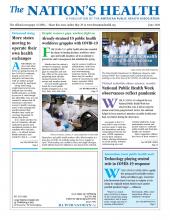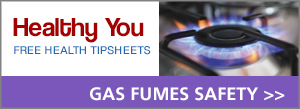
Researchers and public health workers collect blood samples at a drive-thru COVID-19 antibody testing site in Los Angeles in April. With funding cuts, workforce losses and supply shortages, health officials have been fighting to stay ahead of the outbreak.
Photo by Kit Karzen, courtesy L.A. County Department of Public Health
For years, U.S. public health advocates sounded the alarm on funding declines, workforce shortages and health inequities, all in an attempt to prevent the stark consequences that unfolded this spring.
Months into the nation’s COVID-19 response, health agencies struggled with gaps in response and testing, while at the same time preparing their already-strained systems for the weeks and months ahead.
As local health agencies faced the worst public health emergency in a century, they were also bracing for serious workforce ramifications, both from the economic downturn and overwhelming response needs. Among those may be another round of recession-era staff losses, reported APHA member Lori Tremmel Freeman, MBA, CEO at the National Association of County and City Health Officials.
Since 2008, following the last great economic downturn, state and local public health has lost nearly a quarter of its workforce, with about 55,000 local health department jobs lost to layoffs and attrition in nearly a decade. COVID-19 threatens to do the same, and in some communities, it already has. In Cincinnati, for example, budget shortfalls forced the city to furlough more than 1,700 employees, including a third of the city’s health department.

Workers conduct COVID-19 testing in Los Angeles in April.
Photo by Kit Karzen, courtesy L.A. County Department of Public Health
The key to stemming that crack before it widens, Tremmel said, is getting emergency federal funds down to the local level as soon as possible so that city and county governments can retain staff despite losses in local tax revenue. As of mid-April, the Centers for Disease Control and Prevention had awarded hundreds of millions in emergency dollars to states; but Tremmel said a patchwork of state disbursement systems makes it difficult to track exactly how the funding is being distributed locally.
“Public health isn’t a thing or a product — it’s a person,” she told The Nation’s Health. “The question that keeps me up is, ‘At what point in this pandemic will we have even more diminished capacity?’”
As the consequences of cutting budgets and sidelining science come to fruition, other looming concerns for U.S. public health include worker burnout, reduced capacity for other critical public health functions, worsened health inequities and tarnished community trust.
In April, for example, local health departments reported having to sideline services such as HIV and STD screening and prevention as well as shift focus from ongoing epidemics such as opioid addiction to battle COVID-19. Brian Castrucci, DrPH, MA, president and CEO of the de Beaumont Foundation, said such capacity issues will also make it harder to respond to problems that generally accompany high unemployment, such as spikes in addiction, abuse and mental distress.
“This is about disinvestment in public health and neglectful social policy,” said Castrucci, an APHA member. “We were ill-prepared — it just didn’t have to be this bad.”
Funding has to be a priority, both for immediate and future workforce needs, he said. An April report from the Association of State and Territorial Health Officials and the Johns Hopkins Center for Health Security called for $3.6 billion to fund 100,000 additional contact investigators, which it noted is less than half the number employed in Wuhan City, China, where COVID-19 was first detected.
In the longer term, Castrucci said policymakers need to quickly widen the pipeline into state and local health and address previously predicted shortages with incentives such as student loan repayments for people serving in governmental public health.
Also on the ground, resources are needed to increase case-based intervention, ideally with trusted members from within communities, and establish frameworks to effectively track and leverage new troves of COVID-19 data to better prevent and stop its spread.
“It’s a huge and complicated undertaking,” said Jennifer Nuzzo, DrPH, SM, senior scholar at the Johns Hopkins Center for Health Security.

In April, Armen Henderson, MD, right, speaks with nursing students in Miami. The health workers provided COVID-19 testing and aid to people in the community who are homeless.
Photo by Joe Raedle, courtesy Getty Images
The nation needs a rapid and unprecedented scale-up in its public health workforce, she said.
“We have yet to understand how this will impact society, but I’m convinced the impacts will be enormous,” Nuzzo told The Nation’s Health. “I hope we’ve finally convinced the world that without our health, we have nothing.”
Schools of public health are among those organizing to help state and local public health officials meet the pandemic challenge. At the University of Maryland School of Public Health, faculty set up an incident command center and the school is working with public health agencies in the state to help ramp up resources, estimate future capacity needs, and educate the community on protecting their physical and mental well-being.
Boris Lushniak, MD, MPH, dean at the school and former U.S. acting surgeon general, said the school is working more closely with local health agencies than ever before, hoping to serve as a supplemental volunteer workforce as response activities evolve.
“You have to be an optimist in public health,” he told The Nation’s Health. “When I turn to students now, they’re fully understanding more so than ever the true role of public health. We have to learn from this and get better at it, and as educators, we play a key role in that.”
Laura Magaña, PhD, MS, president and CEO of the Association of Schools and Programs of Public Health, agreed, noting that while the field’s “unprecedented” visibility come from enormous tragedy, the chance to build new support for stronger health systems and a robust workforce should not go to waste.
“Right now, every single person in the world knows exactly what we do, so hopefully we will finally learn our lesson about funding public health,” she told The Nation’s Health, adding that she expects schools will see an uptick in people wanting to study the discipline.
Despite the formidable challenges, “local public health is used to doing a lot with little resources,” said NACCHO’s Tremmel.
In Nebraska, for example, local public health workers quickly formed a community task force to find and purchase personal protective equipment for responders in rural areas, knowing such communities would likely face problems accessing the in demand items. But in the face of COVID-19, such dedication will need serious resources and funding to back it up and sustain critical functions.
“Emergency funding is great during an emergency, but we need some sustainable investments in the public health infrastructure,” she said. “It’s the only thing that will protect us moving forward.”
For more information on needs and challenges of the U.S. public health workforce, visit www.phwins.org.
- Copyright The Nation’s Health, American Public Health Association









